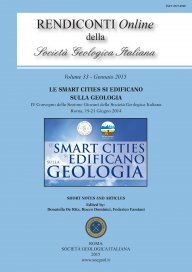
Geochemistry and mineralogy of the Triassic mudstones from the Brembana Valley (Lombardian Basin, northern Italy)
Francesco Perri (*), Annunziata Loiacono (*), Salvatore Critelli (*) & Flavio Jadoul (**)
(*) Dipartimento di Biologia, Ecologia e Scienze della Terra, Università della Calabria, 87036 Arcavacata di Rende (CS). E-mail: nunzialoiacono@yahoo.it
(**) Dipartimento di Scienze della Terra "Ardito Desio", Università degli Studi di Milano, 20133 Milano.
DOI: https://doi.org/10.3301/ROL.2015.17
Volume: 33/2015
Pages: 71-74
Abstract
Chemical and mineralogical composition of Triassic mudstones form the Brembana Valley (Lombardian Basin) have been determined to characterize their sedimentary history and the relationships between source area and depositional basin. Mudstones include abundant phyllosilicates, while quartz, carbonates (calcite and dolomite) and feldspars (plagioclase and K-feldspar) are minor. Clay fraction includes illite, kaolinite and chlorite with minor amounts of I/S mixed-layer. The order of interstratified I/S suggests a temperature of 160-180°C, typical of the deep diagenesis/anchizone. The CIA value is on average 66, suggesting a low-moderate alteration of the source area. The 15Al2O3-Zr-300-TiO2 diagram show a trend of mixing in the direction of the Zr apex typical of sediment recycling. The ICV values for the studied samples are <1 (on average 0.84) suggesting that mudstones are compositionally mature; these values are probably related to recycling processes as shown by the Al-Zr-Ti plot. The studied samples have Al2O3/TiO2 values ranging from 17 to 34; these values suggest that the mudstones were formed in environments characterized by humid and semi-arid climates. The Al2O3 vs. TiO2 and Cr/V vs. Y/Ni plots indicates that the source areas are mainly composed of felsic rocks with minor/negligible mafic-ultramafic supply.
Keywords
Get Full Text